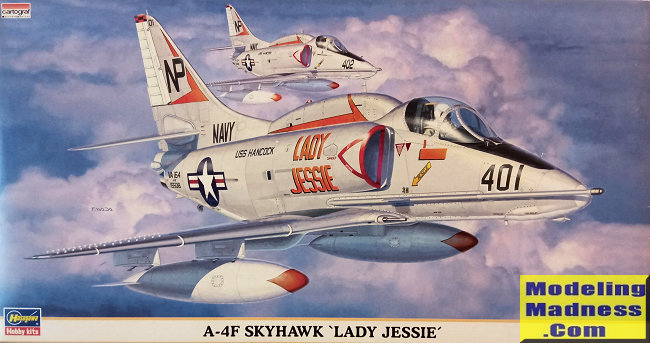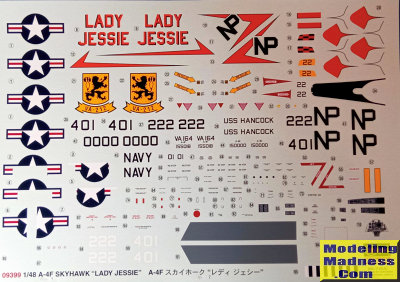
Hasegawa 1/48 A-4F Skyhawk 'Lady Jessie'
| KIT #: | 09399 |
| PRICE: | $30.00 when new |
| DECALS: | Two options |
| REVIEWER: | Spiros Pendedekas |
| NOTES: | Still an excellent kit. |

| HISTORY |
The Douglas A-4 Skyhawk is a
small single-seat, single engine, delta-winged subsonic carrier-capable light
attack aircraft developed for the USN and the USMC in the early 1950s.
Nicknamed “Scooter”, relatively light and with a good top speed of 670 mph, this
successful aircraft could be loaded with a variety of ordnance, being able not
only of carrying a bomb load equivalent to that of Boeing B-17, but also to
deliver nuclear weapons using a low-altitude bombing system and a "loft"
delivery technique.
Skyhawks played key roles in the Vietnam War, the Yom Kippur War, and the
Falklands War. As of 2022, some still remain in service with the Argentine Air
Force and the Brazilian Naval Aviation.
| THE KIT |
 Hasegawa came in 2000
with their very nice new tool single seater A-4 series, with the much
anticipated dual seater versions starting to appear after 2009. Per the Hasegawa
trend, these kits were expected to be frequently reissued with the occasional
extra parts, in order to cater for various versions and, of course, typically
interesting decal schemes. In the A/TA-4 case, Hasegawa outdid themselves, with
the total number of editions clocking up to 44 (excluding the 2 OA-4 Monogram
reboxes)! My copy was the 2001 A-4F “Lady Jessie” edition, bought from one of my
usual (and, sadly, either systematically closing or gradually transforming to
the "sign 'o' the times" internetic) hobby shops in Athens back in 2004.
Hasegawa came in 2000
with their very nice new tool single seater A-4 series, with the much
anticipated dual seater versions starting to appear after 2009. Per the Hasegawa
trend, these kits were expected to be frequently reissued with the occasional
extra parts, in order to cater for various versions and, of course, typically
interesting decal schemes. In the A/TA-4 case, Hasegawa outdid themselves, with
the total number of editions clocking up to 44 (excluding the 2 OA-4 Monogram
reboxes)! My copy was the 2001 A-4F “Lady Jessie” edition, bought from one of my
usual (and, sadly, either systematically closing or gradually transforming to
the "sign 'o' the times" internetic) hobby shops in Athens back in 2004.
Typically for Hasegawa, the kit comes in an excellent quality medium sized top
opening box, with the usual equally excellent Koike Shigeo boxart, depicting
“Lady Jessie” flying in formation with another VA-164 bird. Upon opening the
box, I was greeted with 166 light gray styrene parts arranged in 8 medium sized
sprues. Plastic is of typical “modern” Hasegawa quality, tad on the hard side
and molding is first class with minimal - if any - flash. All sprues are bagged
together, meaning some potential scratches, with, at least the clear fret
separately sealed.
Surface detail looks superb with nicely engraved panel lines. Not all parts are
to be used for building this kit, seemingly Hasegawa having molded together some
parts that are destined for other versions.
Cockpit looks well appointed and the 5-piece seat is believable. Nice decals are
to be affixed and (with the aid of decal softener) succumb onto the instrument
panel and side consoles which feature already molded-on instruments, with the
final looks typically at Hasegawa kits looking very nice.
The intakes seem well appointed and done in full depth, ending in a good looking
compressor face. The tail pipe looks well done too, as does the distinctive hump
that is used in one of the two kit versions. A nice step ladder is also
provided.
Landing gear looks very good, with the brake calipers nicely molded, the bays
and door innards well detailed and the main wheels nicely futuring separate
external rims (making painting a breeze), the only minor remark being the one
piece nose leg that has the wheel molded on: a number of modelers prefer it to
be separately provided, so the looks will be more realistic.
Flaps, slats and air brakes are separately provided (most ground pics depict
Skyhawks with flaps down, slats “deployed” and air brakes either slightly
deployed or fully retracted). The distinctive external tanks and their pylons
look really nice (with “fiined” or “un-finned” tanks optionally built) , as do
the other two external pylons and the ventral one. Per the usual Hasegawa trend,
no ordnance is provided, which you have to buy separately, something not that
favorable, especially taking into account the not particularly low basic kit
price and the fact that most modelers would go for nothing less than a fully
armed “Scooter”.
Transparencies are superbly molded and crystal clear. Instructions come to the
usual excellent Hasegawa pamphlet, containing a pleasantly read short history of
the type, a parts list, with the construction spread in 13 concise steps, where
the options or version differences are clearly indicated and of course color
callouts also given where applicable.
 Two schemes are provided, one being VA-212’s 150000/222 machine, the other
being VA-164’s 155018/401 “Lady Jessie”, both of them being gull gray over
white. Colors are typically given in Gunze Sangyo, Mr Color and in generic form.
Decals are superbly printed by Cartograf and look to be still in pristine
condition.
Two schemes are provided, one being VA-212’s 150000/222 machine, the other
being VA-164’s 155018/401 “Lady Jessie”, both of them being gull gray over
white. Colors are typically given in Gunze Sangyo, Mr Color and in generic form.
Decals are superbly printed by Cartograf and look to be still in pristine
condition.
Instructions want you to first assemble the cockpit, intake duct and tail pipe
and trap them between the fuselage halves. An unspecified amount of ballast must
also be trapped at the front: since the model will be a serious candidate for
tail sitting, I would stuff some serious amount in the nose area (you can get an
idea from one of
our Editor’s builds).
Assembly and installation of the
air intakes and the distinctive hump (which is correct only for the one of the
two kit versions) is next, followed by assembly and installation of the wings,
where you will have to pose the flaps and slats at your desired position (the
slats are only depicted in “retracted” position at the instructions, so you
should consult your references in order to place them correctly deployed). If
attaching pylons (which is the “natural” thing to do, unless you model an
aerobatic bird or so…), you must predrill the indicated holes before assembling
the main wing.
Landing gear installation and various external bits attachment comes next,
followed by the exhaust nozzle and air brakes (the latter are depicted “open”, a
posture, as stated above, rarely witnessed when on ground, usually they were
either shut or slightly open).
Pylons, drop tanks (where you have to choose between “finned” or “unfinned”),
external ladder, transparencies and various “delicate stuff” are finally to be
attached, ending a build of seemingly average complexity.
| CONCLUSIONS |
This is still an absolutely fine
kit of the iconic Skyhawk. General shape of parts looks correct, details are
sufficiently provided, especially at all key areas, molding is excellent,
transparencies are nice and clear and decals are supreme. Even out of the box, a
superb looking model can emerge. Construction itself, though not basic, does not
not look too complicated, with the excellent instructions deeming the kit
suitable for anyone but the absolute beginner.
The kit builds nicely, as the numerous reviews found at the MM archives clearly
indicate. The particular kit is not that easy to find nowadays (as of 2022),
but, for sure you can find later reboxings of similar versions, most of the time
sensibly priced. If you fancy the type, this is a kit worth building.
Happy modeling!
September 2022 Copyright ModelingMadness.com. All rights reserved. No
reproduction in part or in whole without express permission. If you would like your product reviewed fairly and fairly quickly, please contact the editor
or see other details in the
Note to
Contributors.